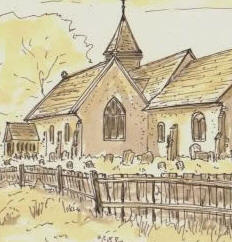
The People, Priests and Problems of a Country Parish
Is the title of Jon Lander’s pamphlet documenting Twelve hundred years in the life of St Mary the Virgin, West Bergholt. The pamphlet is included here in full in sections, each accessible through the navigation menu above and links below, the introductory paragraphs of the first three sections are shown below.
The Saxons and Normans
The archives tell us that the old church of St Mary’s in West Bergholt has had forty Rectors in the last thousand years and it is good to have such a full record. But there were many more whose names were not recorded. The deacons Robert, Alan and Richard who served the church in the 12th century (History of the Counties of England: The History Of Essex, OUP, Oxford, 2001, Vol. X, p35.) are the first we know about. But the old stone-built church of St Mary the Virgin had been there for more than a hundred years before they were born and there had been a wooden church before that. So it is likely there have been priests leading worship on this same patch of land since Christianity arrived in East Anglia in the seventh century.
The Tudor tumult
The Sackvilles, who arrived from Normandy shortly after the Conquest, held the Lordship for more than 300 years. Most of the Sackvilles were close to the royal court. The last of the family to be Lord of Bergholt Manor, Sir Richard, was Treasurer of the Exchequer and was appointed to organise the coronation of Queen Elizabeth I. After the Sackvilles, the advowson was either inherited or sold until 1946 when the Bishop of Chelmsford assumed the right to appoint the priest.
The Stuart tragedy
After the death of Queen Elizabeth in 1603 came James I (James VI of Scotland) and there is a tangible reminder of his reign in the old church of St Mary. Painted on the tympanum above the nave are James’s royal arms. They were undiscovered until 1986 when a team of experts removed the five layers of lime wash that hid them from view. The top of the painting is still partly hidden by the curved ceiling which was added long after the arms were painted. Only traces of the royal motto “Honi Soi Qui Mal y Pense” remain, but beneath the arms the words “Exurgat Deus dissipenter inimici” can be clearly seen. They are the opening words of Psalm 68: “Let God arise and let his enemies be scattered.
Through to the 20th Century
St Mary’s was described as “a rich living” in the middle ages. In 1254, it was valued at 100 shillings and, given that the Rector did not have to put petrol in his car or pay electricity and gas bills, it was probably a reasonable income. He was also able to grow a lot of his food. By 1535, the priest’s income had risen to £10 with another pound from tithes (A levy every citizen paid to support the church and its clergy.). In 1564 the glebe – or land that goes with the living – consisted of 27 acres of pasture and wood worth £20. By 1835, the gross income of the rectory had risen to £463. (The History Of Essex, OUP, Oxford, 2001, Vol. X, p35.)
List of rectors & their patrons.

